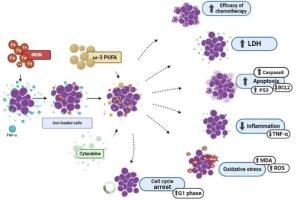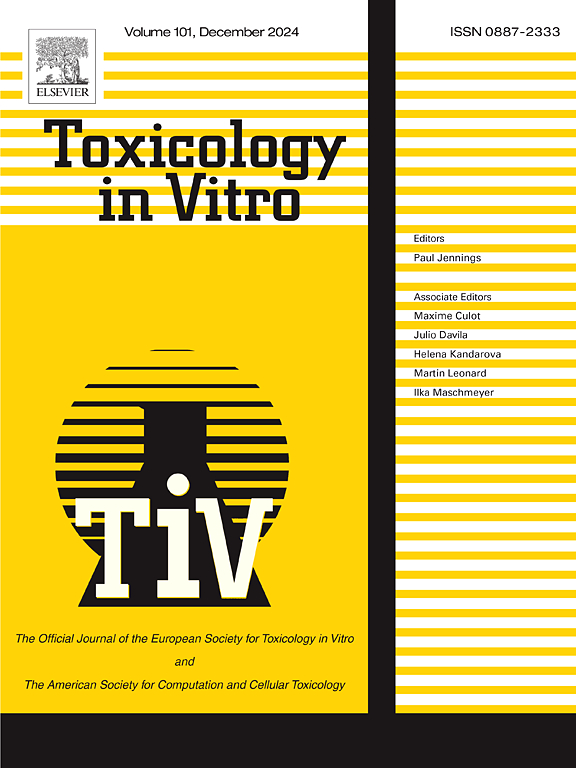n-3多不饱和脂肪酸通过凋亡和氧化途径增强阿糖胞苷对铁超载NALM-6细胞的作用
IF 2.6
3区 医学
Q3 TOXICOLOGY
引用次数: 0
摘要
尽管急性淋巴细胞白血病(ALL)的治疗取得了进展,但化疗毒性和输注铁超载的不良反应继续影响患者的生活质量。多不饱和脂肪酸(PUFAs)在白血病中具有抗肿瘤和抗炎特性。本研究探讨了n-3 PUFA对铁超载细胞中阿糖胞苷功效的影响。采用柠檬酸铁铵(FAC)诱导NALM-6细胞铁超载,并通过原子吸收光谱(AAS)定量。通过MTT、乳酸脱氢酶(LDH)、细胞凋亡和细胞周期测定来评估n-3 PUFA对NALM-6细胞对阿糖胞苷反应的影响。此外,对凋亡、抗凋亡和炎症基因以及氧化应激标志物(如活性氧(ROS)和丙二醛(MDA)水平)进行基因表达分析。n-3 PUFA显著增强了阿糖胞苷在铁超载NALM-6细胞中的有效性,导致LDH分泌增加,凋亡率升高,G1期细胞周期阻滞。这些作用与凋亡基因如P53和caspase-8的上调,抗凋亡基因Bcl2的下调以及炎症基因TNF-α的降低有关。此外,ROS和MDA水平显著升高。总的来说,n-3 PUFA处理通过激活凋亡过程和氧化应激途径,提高了阿糖胞苷对铁超载NALM-6细胞的疗效。本文章由计算机程序翻译,如有差异,请以英文原文为准。

n-3 polyunsaturated fatty acids enhanced efficacy of cytarabine in iron-overloaded NALM-6 cells via apoptotic and oxidative pathways
Despite progress in treating acute lymphoblastic leukemia (ALL), the adverse effects of chemotherapy toxicity and iron overload from transfusions continue to affect patients' quality of life. Polyunsaturated fatty acids (PUFAs) exhibit both antitumor and anti-inflammatory properties in leukemia. This study investigated the influence of n-3 PUFA on the efficacy of cytarabine in cells with iron overload. Iron overload was induced in NALM-6 cells using ferric ammonium citrate (FAC) and quantified through atomic absorption spectroscopy (AAS). The impact of n-3 PUFA on NALM-6 cells' response to cytarabine was evaluated using MTT, lactate dehydrogenase (LDH), apoptosis, and cell cycle assays. Additionally, gene expression analyses were performed on apoptotic, anti-apoptotic, and inflammatory genes, along with oxidative stress markers such as reactive oxygen species (ROS) and malondialdehyde (MDA) levels. The administration of n-3 PUFA significantly enhanced the effectiveness of cytarabine in iron-overloaded NALM-6 cells, leading to increased LDH secretion, elevated apoptosis rates, and G1 phase cell cycle arrest. These effects were associated with the upregulation of apoptotic genes such as P53 and caspase-8, the downregulation of the anti-apoptotic gene Bcl2, and a decrease in the inflammatory gene TNF-α. Furthermore, there was a notable increase in ROS and MDA levels. Overall, n-3 PUFA treatment improved cytarabine's efficacy in iron-overloaded NALM-6 cells by activating apoptotic processes and oxidative stress pathways.
求助全文
通过发布文献求助,成功后即可免费获取论文全文。
去求助
来源期刊

Toxicology in Vitro
医学-毒理学
CiteScore
6.50
自引率
3.10%
发文量
181
审稿时长
65 days
期刊介绍:
Toxicology in Vitro publishes original research papers and reviews on the application and use of in vitro systems for assessing or predicting the toxic effects of chemicals and elucidating their mechanisms of action. These in vitro techniques include utilizing cell or tissue cultures, isolated cells, tissue slices, subcellular fractions, transgenic cell cultures, and cells from transgenic organisms, as well as in silico modelling. The Journal will focus on investigations that involve the development and validation of new in vitro methods, e.g. for prediction of toxic effects based on traditional and in silico modelling; on the use of methods in high-throughput toxicology and pharmacology; elucidation of mechanisms of toxic action; the application of genomics, transcriptomics and proteomics in toxicology, as well as on comparative studies that characterise the relationship between in vitro and in vivo findings. The Journal strongly encourages the submission of manuscripts that focus on the development of in vitro methods, their practical applications and regulatory use (e.g. in the areas of food components cosmetics, pharmaceuticals, pesticides, and industrial chemicals). Toxicology in Vitro discourages papers that record reporting on toxicological effects from materials, such as plant extracts or herbal medicines, that have not been chemically characterized.
 求助内容:
求助内容: 应助结果提醒方式:
应助结果提醒方式:


